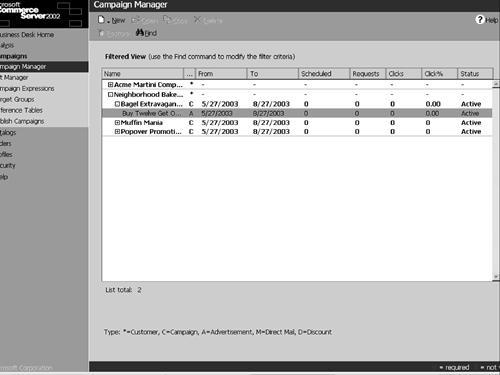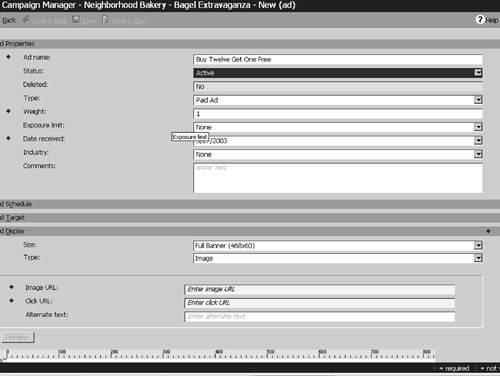Advertising Based on Profiles
| < Day Day Up > |
| As we have shown, personalization can take many forms. One of the more powerful is to create marketing campaigns based on user profiles. You may want to consider this an involuntary form of the subscriptions and notifications discussed in the previous section. The Microsoft Commerce Server Business Desk lets you display advertisements to users based on values in their user profiles. The ads can be placed in the banner section of the page header. You can use complex criteria to determine ad display. The criteria are used as the basis of a calculation for determining which, if any, ad will appear. For instance, you may be trying to sell an exciting new model of men's hip waders. The first criteria are that the user is a man and enjoys fishing . You may want to exclude customers who have purchased hip waders in the past six months. Special priority should be giving to customers who have expressed an interest in fly fishing, as waders are more often used for fly fishing than for bass or saltwater fishing. You can also target people who are not customers. For instance, you might want to provide an incentive for visitors to your site to place their first orders. You could create an ad that would only be visible to new users and that would offer free shipping or a discount on their first order from the store. Advertising online with Commerce Server is powerful and flexible. The ad campaigns can:
If you are running an e-commerce web site, you will need no convincing of the benefits of advertising both as a source of revenue and as a way to drive sales on your site. If you are running a government or nonprofit site, advertising can be just as valuable , albeit in a less blatantly capitalistic way. You could create the online equivalent of public service ads to give users information that they need. An association could promote its annual meeting or use an ad to announce a new publication. County government could promote its latest online service such as tax payment or employment assistance. You determine the look of ads, and you can make them as subtle or jolting as you want. Advertising is also valuable for an enterprise portal. A human resources department could promote new company benefits and encourage people who have not set up their retirement plan to do so. Management might want to target advertising to new employees or by department. Training and education could be promoted through advertisements targeted to the people who are most likely to take a certain class. The Commerce Server Business Desk contains a Campaign Manager module to enter details surrounding an advertising campaign (Figure 8.18). You enter a list of your advertising customers, and then each of the campaigns, including a link to the ad itself. For Commerce Server, a campaign consists of the activity around a single ad. Figure 8.18. Campaign Manager You can control the duration and placement for each ad as well as many other factors (Figure 8.19). Figure 8.19. New Campaign Commerce Server employs a concept called expression-based targeting to deliver personalized content to users. The expressions are conditions that determine whether content is suitable for a customer. For instance, if the expression "preferred music=jazz" is true for a user, that user might be targeted to receive news of a special sale on Blue Note recordings or a new album from Wynton Marsalis. You obtain values to test the expression directly from the user or by monitoring user behavior. Users who choose jazz as their favorite music might appreciate music suggestions for this genre . You could also infer that a user was a jazz fan if 80% of the compact discs they have purchased from your site are jazz. You can create two types of expressions, target expressions and catalog expressions. Target expressions relate to the targeted audience for the campaign, while catalog expressions are tied to catalog items. You could use a target expression of "purchases in last month > 5" to provide a discount to frequent shoppers or a catalog expression of "item type=sleeping bag and price > $200" to offer an early season discount for high-end sleeping bags. Catalog expressions are used for cross-selling , such as promoting hot dog buns to customers who purchase hot dogs. You can combine these expression types to create richer and more interesting marketing initiatives. You could offer discounts on certain items to specified groups of customers, for example. The expressions could be weighted so one criterion overruled others or the evaluated expressions were added together to determine whether content passed or failed the test. The Commerce Server Business Desk provides an Expression Builder tool (Figure 8.20) to craft these expressions. It is based on dynamic HTML (DHTML) to allow the style sheets of the parent site to cascade to the Expression Builder. The site manager would typically provide the Expression Builder tool to users who create marketing campaigns within a web interface (Figure 8.20). Figure 8.20. Expression Builder One or more expressions are used to target groups that will view the ads. These expressions may be mandatory for the target group , and you can even enter expressions that cause a user to be excluded. You use the ContentSelector objects to select the proper content for the user based on profile information (Listing 8.4). Listing 8.4. Using ContentSelector Objects <% ' Create a ContentSelector object. Set CSO = Server.CreateObject("Commerce.ContentSelector") ' Use the GetContent method to get some content. Use the dictionary ' previously created in the Global.asa file and referenced through _ the ' Application collection. Set Ads = CSO.GetContent(Application("CSFAdsContext")) ' Ads is a SimpleList containing the selected content. ' Write the content to the page, if any. For Each Ad in Ads Response.Write(Ad) Next %> Source: Commerce Server Help File (books online) When you create an ad, you determine when, where, and to whom it is displayed. Commerce Server uses the following parameters to place the ad:
You may want to target the content with localization, such as the appropriate language for the content. If you want to deliver an ad in multiple languages, you must recreate the ad in each target language and enter the ad variables for the ad. If all these ads are not sufficient for reaching your customers, employees, members , or constituents, Commerce Server gives you the ultimate "personalization" weapon. You can extend the campaigns from web ad campaigns to direct mail campaigns by importing mailing lists and generating email or paper mail. |
| < Day Day Up > |
EAN: 2147483647
Pages: 164


